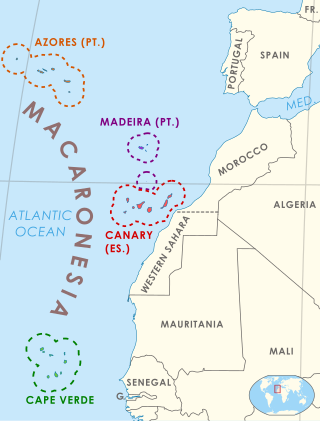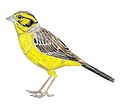Top Qs
Timeline
Chat
Perspective
List of Macaronesian animals extinct in the Holocene
From Wikipedia, the free encyclopedia
Remove ads
This is a list of Macaronesian animals extinct in the Holocene that covers extinctions from the Holocene epoch, a geologic epoch that began about 11,650 years before present (about 9700 BCE)[a] and continues to the present day.[1]


Macaronesia is a collection of four volcanic archipelagos in the North Atlantic, off the coast of Africa.[2] Macaronesia consists of the Azores (part of Portugal), Maderia (part of Portugal), the Canary Islands (part of Spain), and Cape Verde (an independent country).
Numerous animal species have disappeared from the Macaronesian islands as part of the ongoing Holocene extinction, driven by human activity.
Remove ads
Mammals (class Mammalia)
Rodents (order Rodentia)
Old World rats and mice (family Muridae)
Carnivorans (order Carnivora)
Earless seals (family Phocidae)
Locally extinct
Remove ads
Birds (class Aves)
Landfowl (order Galliformes)
Pheasants and allies (family Phasianidae)
Pigeons and doves (order Columbiformes)
Pigeons and doves (family Columbidae)
Rails and cranes (order Gruiformes)
Rails (family Rallidae)
Shorebirds (order Charadriiformes)
Oystercatchers (family Haematopodidae)
Sandpipers (family Scolopacidae)
Auks (family Alcidae)
Albatrosses and petrels (order Procellariiformes)
Petrels and shearwaters (family Procellariidae)
Hawks and relatives (order Accipitriformes)
Hawks, eagles, kites, harriers and Old World vultures (family Accipitridae)
Locally extinct
Owls (order Strigiformes)
True owls (family Strigidae)
Perching birds (order Passeriformes)
Leaf warblers (family Phylloscopidae)
True finches (family Fringillidae)
Locally extinct
Buntings (family Emberizidae)
Thrushes (family Turdidae)
Remove ads
Reptiles (class Reptilia)
Squamates (order Squamata)
Wall lizards (family Lacertidae)
Possibly extinct
Skinks (family Scincidae)
Turtles and tortoises (order Testudines)
Tortoises (family Testudinidae)
Remove ads
Insects (class Insecta)
Butterflies and moths (order Lepidoptera)
Whites or yellow-whites (family Pieridae)
Possibly extinct
Remove ads
Slugs and snails (class Gastropoda)
Order Stylommatophora
Family Discidae
Possibly extinct
Family Gastrodontidae
Possibly extinct
Family Geomitridae
Possibly extinct, family Geomitridae
Family Lauriidae
Possibly extinct, family Lauriidae
Remove ads
Notes
References
Wikiwand - on
Seamless Wikipedia browsing. On steroids.
Remove ads

























